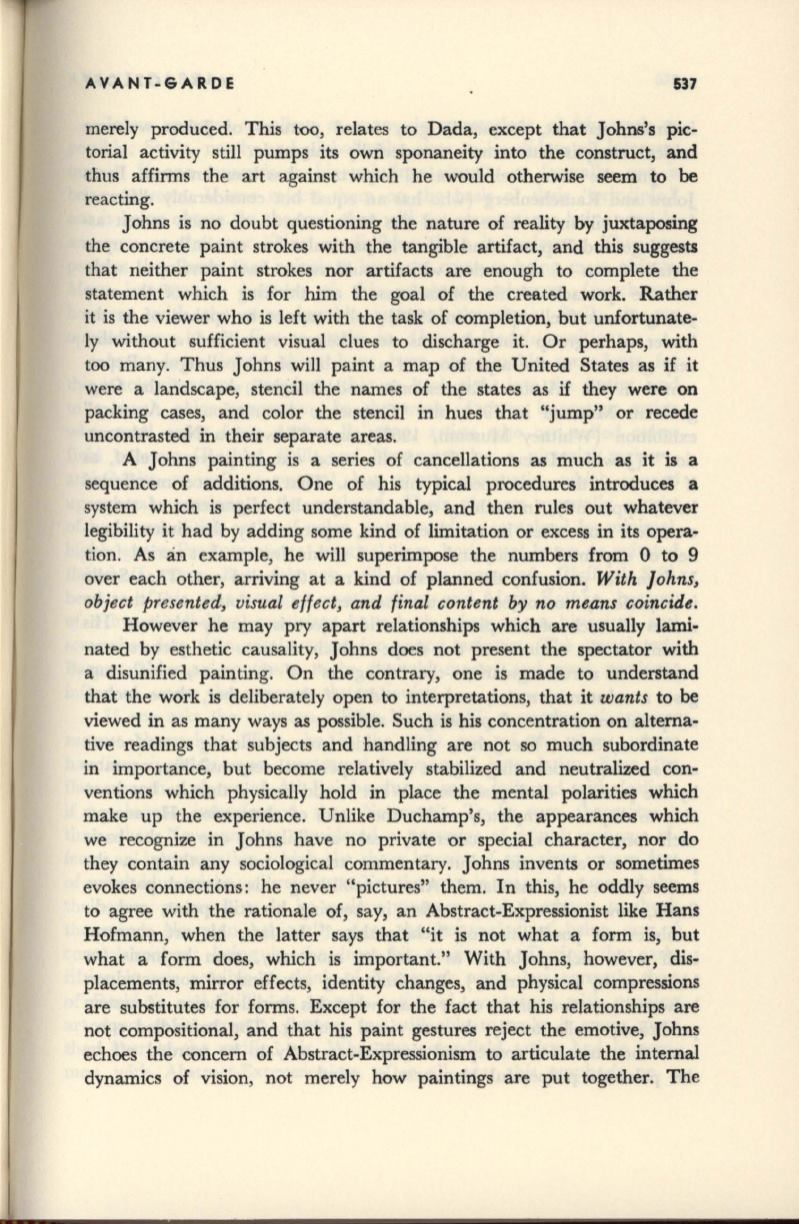

AVANT·GARDE
537
merely produced. This too, relates to Dada, except that Johns's pic·
torial activity still pumps its own sponaneity into the construct, and
thus affinns the art against which he would otherwise seem to
be
reacting.
Johns is no doubt questioning the nature of reality by juxtaposing
the concrete paint strokes with the tangible artifact, and this suggests
that neither paint strokes nor artifacts are enough to complete the
statement which is for him the goal of the created work. Rather
it is the viewer who
is
left with the task of completion, but unfortunate·
ly without sufficient visual clues to discharge it. Or perhaps, with
too many. Thus Johns will paint a map of the United States as if it
were a landscape, stencil the names of the states as
if
they were on
packing cases, and color the stencil in hues that "jump" or recede
uncontrasted in their separate areas.
A Johns painting is a series of cancellations as much as it
is
a
sequence of additions. One of his typical procedures introduces a
system which is perfect understandable, and then rules out whatever
legibility it had by adding some kind of limitation or excess in its opera–
tion. As an example, he will superimpose the numbers from 0 to 9
over each other, arriving at a kind of planned confusion.
With Johns,
object presented., visual effect, and final content by no means coincide.
However he may pry apart relationships which are usually lami–
nated by esthetic causality, Johns does not present the spectator with
a disunified painting. On the contrary, one is made to understand
that the work is deliberately open
to
interpretations, that it
wants
to
be
viewed in as many ways as possible. Such is his concentration on alterna–
tive readings that subjects and handling are not so much subordinate
in importance, but become relatively stabilized and neutralized con–
ventions which physically hold in place the mental polarities which
make up the experience. Unlike Duchamp's, the appearances which
we recognize in Johns have no private or special character, nor do
they contain any sociological commentary. Johns invents or sometimes
evokes connections: he never "pictures" them. In this, he oddly seems
to agree with the rationale of, say, an Abstract-Expressionist like Hans
Hofmann, when the latter says that "it is not what a fonn is, but
what a fonn does, which is important." With Johns, however, dis–
placements, mirror effects, identity changes, and physical compressions
are substitutes for fonns. Except for the fact that his relationships are
not compositional, and that his paint gestures reject the emotive, Johns
echoes the concern of Abstract-Expressionism to articulate the internal
dynamics of vision, not merely how paintings are put together. The









